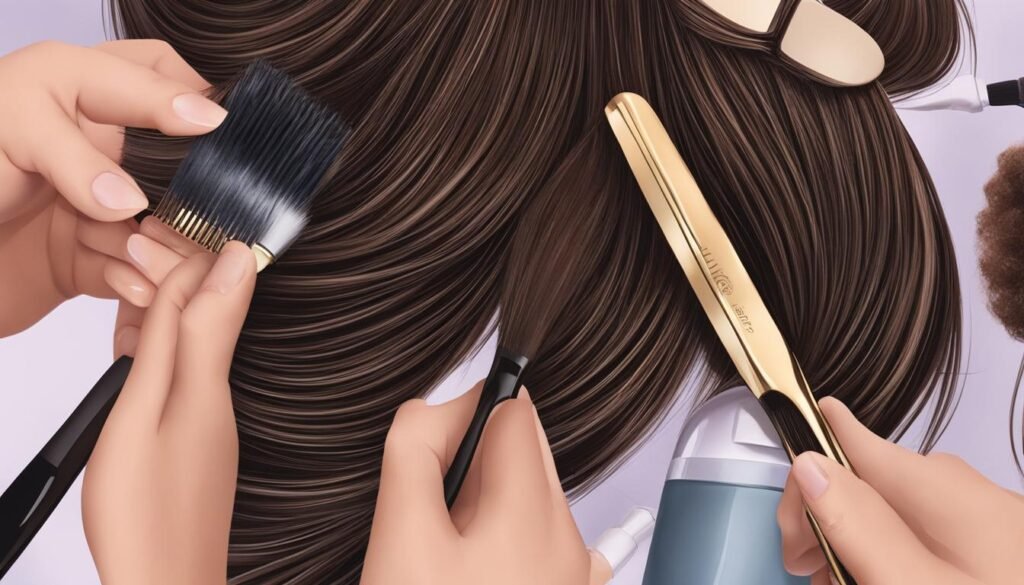Are you tired of dealing with fluffy hair that never seems to stay sleek and smooth? Don’t worry, you’re not alone! Many people struggle with the same problem, wondering why their hair seems to have a mind of its own. In this article, we will explore the causes of fluffy hair and provide you with some valuable tips on how to manage and prevent it.
Fluffy hair can be attributed to different factors, such as hair porosity and an incorrect hair care routine. When the cuticles are lifted, the hair becomes porous, absorbing humidity but unable to retain moisture. This results in dry and frizzy hair that appears fluffy. Additionally, using the wrong hair treatments and styling techniques such as vigorous brushing or blow-drying can contribute to the fluffiness.
To manage fluffy hair effectively, it’s essential to use a mild shampoo, hydrating treatments, and regular oil baths. Styling techniques, such as diffusing for curly hair or precise blow-drying for straight hair, can help control fluffiness. In the upcoming sections, we will delve deeper into the causes of fluffy hair, provide home remedies for managing it, and share styling tips to tame those unruly locks.
Causes of Fluffy Hair
Fluffy hair can be attributed to various factors that contribute to its dryness and porosity, resulting in frizz and a fluffy appearance. The primary causes of fluffy hair include:
- Dryness and Porosity: When the hair cuticles are lifted, the hair becomes more porous, allowing moisture to be absorbed easily but preventing its retention. This lack of moisture leads to dry, frizzy hair that appears fluffy.
- Haircare Mistakes: Choosing the wrong hair treatments and products that do not cater to the specific needs and dryness of the hair can exacerbate fluffiness.
- Effects of Lifted Cuticles: Over-brushing the hair or blow-drying it in multiple directions can cause the cuticles to stand on end, contributing to fluffiness.
- Frizz and Fluffiness: Certain dietary and health factors, friction from brushing and tight hairstyles, heat styling, and exposure to chemicals and weather conditions can also play a role in causing fluffy hair.
Understanding these causes is crucial in effectively managing and controlling fluffy hair. By addressing these underlying factors, individuals can achieve smoother, more manageable hair.
Image:
How to Manage Fluffy Hair
Managing fluffy hair can be a challenge, but with the right tips and techniques, you can keep your locks under control and minimize frizz. Incorporating these practices into your hair care routine will help you achieve smooth, manageable hair.
1. Use a Moisturizing Shampoo
To combat dryness and fluffiness, opt for a moisturizing shampoo designed specifically for dry and damaged hair. Look for products that contain hydrating ingredients like argan oil or shea butter. Avoid shampoos that contain sulfates, as they can strip away natural oils, making your hair even drier. Limit hair washing to every other day or less to maintain the hair’s natural moisture balance.
2. Deep Conditioning for Smoother Hair
Deep conditioning is essential for reducing fluffiness and adding much-needed moisture to your hair. Invest in a nourishing hair mask that is specifically formulated for smoothness and hydration. Apply the mask once a week, focusing on the ends and any particularly dry areas. Leave it on for the recommended time and rinse thoroughly to reveal softer, more manageable hair.
3. Protect Your Hair from Heat
Heat styling tools can exacerbate fluffiness and damage your hair. Before using any heat styling tools, be sure to apply a heat protectant spray or serum to create a protective barrier between your hair and the heat. Avoid excessive heat styling and opt for air drying whenever possible. Embrace your natural texture to minimize frizz and maintain healthy hair.
4. Practice Gentle Detangling
Tangled hair can lead to breakage and contribute to fluffiness. When detangling, use a wide-toothed comb or your fingers to gently work through knots. Start detangling from the ends and work your way up to the roots. This method will help prevent unnecessary damage and minimize frizz.
5. Create a Personalized Hair Care Routine
Every individual’s hair is unique, so it’s important to develop a personalized hair care routine that caters to your specific needs. Consider factors such as your hair type, texture, and level of dryness. Experiment with different products and techniques until you find the perfect combination that works for you. Regularly reassess and adjust your routine as needed to keep your hair healthy and manageable.
By following these tips and incorporating them into your hair care routine, you can effectively manage fluffy hair and achieve smooth, beautiful locks. Remember to be patient and consistent, as it may take time to find the best products and techniques that work for your hair.

| Product | Description |
|---|---|
| Moisturizing Shampoo | Avoids stripping natural oils, adds hydration |
| Deep Conditioning Hair Mask | Nourishes and smooths the hair |
| Heat Protectant Spray | Creates a barrier against heat damage |
| Wide-Toothed Comb | Gentle detangling to prevent breakage |
Home Remedies for Fluffy Hair
Fluffy hair can be frustrating to manage, but there are several home remedies you can try to tame those unruly locks. These DIY treatments are easy to make and use, and they can help nourish and hydrate your hair, resulting in smoother and less fluffy strands. Here are some effective home remedies for fluffy hair:
1. DIY Hair Masks
Creating your own hair masks using natural ingredients can provide intense hydration and nourishment to your fluffy hair. These masks can help smooth the cuticles and reduce frizz. Consider using ingredients like avocado, honey, yogurt, or banana, which are rich in vitamins and antioxidants that promote hair health.
2. Natural Oils for Hydration
Natural oils are excellent moisturizers for fluffy hair. Argan oil, jojoba oil, and coconut oil are known for their nourishing properties. Apply a few drops of your preferred oil to your damp hair, focusing on the ends to add hydration and prevent frizz. You can also mix different oils for a customized blend that suits your hair’s needs.
3. Aloe Vera for Frizz Control
Aloe vera gel is a natural remedy that can help control frizz and reduce fluffiness. Apply a small amount of pure aloe vera gel to your hair, focusing on the mid-lengths and ends. Leave it in as a leave-in treatment to enjoy its hydrating and frizz-taming benefits. Aloe vera also helps soothe the scalp and promote hair growth.
4. Use of Honey
Honey acts as a natural humectant, attracting and retaining moisture in the hair. Mix a tablespoon of honey with some warm water and apply it to your hair, making sure to distribute it evenly. Leave it on for about 30 minutes before rinsing it out. Honey will leave your hair feeling soft, hydrated, and less fluffy.
5. Hair-Friendly Vitamins and Minerals
Including hair-friendly vitamins and minerals in your diet can promote healthier and less fluffy hair. Vitamins A, C, and E, as well as minerals like zinc and iron, play vital roles in maintaining hair health. Consume foods rich in these nutrients, such as leafy greens, citrus fruits, nuts, and seeds, to support your hair’s overall condition.
Giving these home remedies a try can help you manage your fluffy hair and achieve smoother, more manageable locks. Incorporate them into your hair care routine and enjoy the benefits of natural ingredients for healthy and beautiful hair.
Ingredients for DIY Hair Masks
| Ingredients | Benefits |
|---|---|
| Avocado | Rich in vitamins and healthy fats, provides intense hydration |
| Honey | Natural humectant, attracts and retains moisture |
| Yogurt | Conditions and nourishes the hair, promotes scalp health |
| Banana | Softens the hair, adds shine, and prevents breakage |
Styling Tips for Fluffy Hair
When it comes to managing fluffy hair, styling techniques can make a noticeable difference in reducing frizz and creating a smoother, more polished look. Whether you have curly, wavy, or straight hair, here are some expert tips to help you tame the fluff and embrace your natural texture.
Avoid Brushing Curls
For those with naturally curly hair, brushing is a big no-no when it comes to reducing frizz and fluffiness. Brushing can disrupt the curl pattern and lead to frizz and poufiness. Instead, gently detangle your curls using a wide-toothed comb or your fingers while your hair is wet and coated with a leave-in conditioner or detangling spray. This will help maintain the integrity of your curls and minimize frizz.
Hairstyle Options for Different Hair Lengths
When it comes to styling fluffy hair, choosing the right hairstyle can make all the difference. For medium-length hair, adding layers can help add movement and shape, reducing the appearance of fluffiness. Long, flowing layers can create a soft, cascading effect that adds dimension and reduces bulk. Shorter hair lengths can benefit from textured cuts or pixie styles to add structure and control. Consulting with a professional hairstylist can help you find the perfect haircut to suit your hair type and minimize fluffiness.
Protecting Hair in Humid Conditions
Humid conditions can wreak havoc on fluffy hair, causing it to frizz and expand. To protect your hair in humid weather, it’s essential to carry a hair serum or anti-frizz product that can help control flyaways. Apply a pea-sized amount of the serum onto your palms and gently distribute it through your hair, focusing on the ends and flyaway-prone areas. Additionally, wearing your hair in a loose, low bun or ponytail can help keep it contained and prevent frizz caused by humidity.
Reducing Frizz with Heat Styling
To keep your fluffy hair looking polished and smooth, heat styling tools can be your best friends. When curling your hair with a curling iron or wand, apply a dry oil or heat protection spray to protect your strands from heat damage. Avoid using high heat settings and opt for medium heat instead to prevent excessive drying and potential damage. Remember to always curl away from your face to create a soft, flattering shape, and hold each curl for a few seconds before releasing it. Finish off with a light-hold hairspray to help maintain the curls throughout the day.
| Styling Tips | Benefits |
|---|---|
| Avoid brushing curls | Preserves curl pattern and reduces frizz |
| Choose hairstyles with layers | Adds movement and reduces fluffiness |
| Protect hair in humid conditions | Controls flyaways and prevents frizz caused by humidity |
| Use heat styling tools with heat protection | Creates smooth, defined styles while protecting the hair |
Recommended Products for Fluffy Hair
When it comes to managing fluffy hair, choosing the right products is key. Avoiding alcohol-based formulas is essential, as they can strip moisture from the hair and exacerbate frizz. Instead, opt for moisturizing products specifically designed for dry and damaged hair. These products are formulated to hydrate and nourish the hair, helping to control fluffiness and reduce frizz.
When selecting anti-frizz products, it is important to look for specific ingredients that can effectively combat fluffiness. Natural oils such as argan, avocado, jojoba, almond, olive, coconut, and castor oils are known for their hydrating properties and can help smooth the hair cuticles. Aloe vera, honey, amino acids, panthenol, sea algae, keratin, silk proteins, and vitamins A, C, and E are also beneficial ingredients to look for in anti-frizz products. These ingredients work together to provide moisture, nourishment, and smoothness to the hair, helping to manage fluffy hair effectively.
In addition to store-bought products, homemade remedies can also be effective in taming fluffy hair. DIY hair masks and treatments using these same ingredients can provide similar benefits, promoting hydration, and reducing frizz. By incorporating these recommended products into your hair care routine, you can enjoy smoother, more manageable hair and say goodbye to fluffiness.
